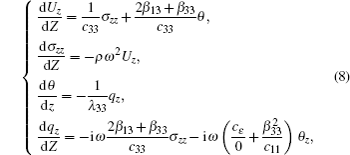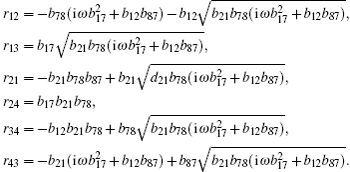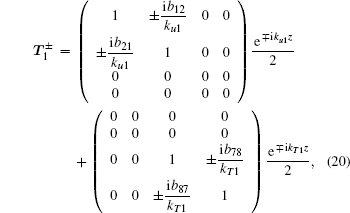† Corresponding author. E-mail:
The thermoelastic wave propagation in a tetragonal syngony anisotropic medium of classes 4, 4/m having heterogeneity along z axis has been investigated by employing matrizant method. This medium has an axis of second-order symmetry parallel to z axis. In the case of the fourth-order matrix coefficients, the problems of wave refraction and reflection on the interface of homogeneous anisotropic thermoelastic mediums are solved analytically.
The theory of elasticity is concerned with the mutual interaction between the mechanical and thermal fields in elastic objects.[1,2] This theory has many important applications in various engineering disciplines, such as civil, mechanical, and nuclear engineering. It is based on the famous hypothesis of Fourier law of heat conduction, by which the temperature distribution is described through parabolic differential equations. According to the theory of elasticity, the thermal signal is propagated instantly throughout the object, which is physically impossible since a finite time is required for the signal propagation. In order to resolve this problem and account for the influence of thermal relaxation time, a modified version of Fourier law known as the generalized thermoelasticity has been proposed. In this modified theory, hyperbolic-type equations are used to predict the heat distribution, hence, the heat propagation in the condensed matter is considered as a wave rather than a diffusion process. In order to investigate the transmission phenomena of waves in anisotropic media with different mechanical and physical properties, matrizant method was employed.[3,4] However, the investigation of thermoelastic wave propagation is based on the simultaneous solution of motion equations and the exact solution of these motion equations can be obtained in integrable cases.[5–7]
The application of matrizant method to non-destructive testing and the wave propagation in thermoelastic media can be found in Ref. [8]. Meanwhile, the propagation of heat wave along an arbitrary axis in orthotropic thermoelastic plates have been investigated by normal modes expansion method.[9] The work in Ref. [9] was done by using the generalized theory of thermoelasticity with single thermal relaxation time. The generalized theory of thermoelasticity has also been used when free harmonic waves interact with media composed of different layers. In such a case, the investigation was made by a technique combining linear transformation and transfer matrix method. By using this technique, the solutions in the case with interaction between free harmonic waves and layered media can be obtained. The importance of these solutions is that they provide dispersion characteristics of multilayered media.
The study of the propagation of thermoelastic waves in anisotropic media is based on the simultaneous solution of equations of motion. The equations of thermal conductivity proposed by Fourier have the following form:[1]



The relationship between stress and strain can be described by Duhamel–Neumann relation as

By using the method of separation of variables, equations (



We consider the problem of thermoelastic wave reflection at the interface between isotropic and anisotropic half-space environment tetragonal syngony classes 4, 4/m with thermomechanical effect. Because of thermomechanical effects, bound thermoelastic waves propagate in the thermoelastic medium.
We suppose that the interface separating two media is z = 0 plane so that the axes of the Cartesian coordinate system coincide with the corresponding crystallographic axes as shown in Fig.
In this case, the incident thermal wave in an anisotropic medium is related to the elastic longitudinal wave of z polarization, and equations (












In an isotropic medium, the incident thermal wave is not related to the elastic properties of medium, so the coefficient matrix of the first medium



As is seen from matrix (



Substituting the matrizant of the second medium (Eq. (




According to Eqs. (


Similarly, according to Eqs. (





According to the matrizant of the first medium 



According to Eqs. (


In this paper, based on the matrizant method,[4] the propagation of thermoelastic waves in an anisotropic medium tetragonal syngony of classes 4, 4/m, in the case of inhomogeneity along z axis has been studied. We have analytically solved the problem of reflection and refraction at the boundary of the homogeneous anisotropic thermoelastic media, in the case of coefficient matrices having order 4. It is expected that our results will be useful for future experiments in various branches of civil and mechanical engineering.
| 1 | |
| 2 | |
| 3 | |
| 4 | |
| 5 | |
| 6 | |
| 7 | |
| 8 | |
| 9 | |
| 11 |




